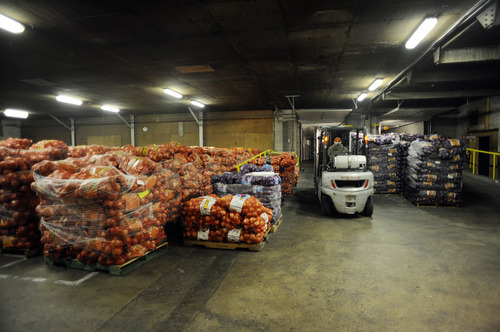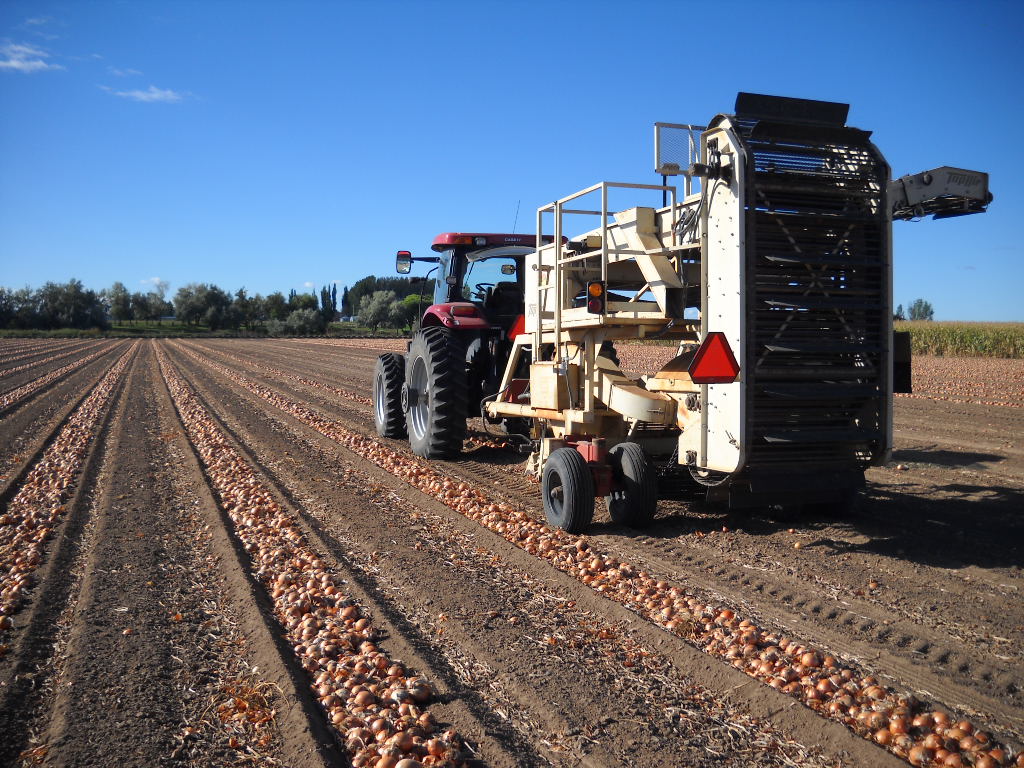Harvest and Handling
Harvesting
For spring-seed onions, harvest starts near the end of August and continues through early October, with the main harvest season being in September. The average yield of onions in Utah is approximately 1,200- 1,500 bags/acre (600-750 cwt/A) with higher yields reaching 2,000 bags/acre (1000 cwt/A).
Research has shown that the optimum harvest time is when onion foliage is still partially erect, and long before maximum yield is attained (when tops are completely down and dry). Yields can increase 30-40% between the stage when tops begin to go down, and the leaves are fully down and dry. It may be tempting to leave onions to cure in the field as long as possible before lifting, but this will reduce the time available for drying. If it rains after onions have been lifted, bulbs may not dry out in the lower daytime temperatures of the early fall. Lifting and curing onions too late into the fall can also expose them to freezing temperatures.
Once harvested, onions need several weeks of warm temperatures in storage to complete the curing process. If bulbs are left too long in the field, quality will be sacrificed when they are brought out of storage due to rots and other storage problems. The optimum time for harvest, therefore, is a balance between highest yields and storage quality.
Undercutting
Mechanically undercut bulbs with rod-weeder diggers or knife undercutters when 60 to 70% of the tops have tipped over and allow bulbs to cure in the field. After about 10 days, the undercut onions are lifted and windrowed.
Topping
Onions can be topped with a Vegi-Vac or a Top-Air machine prior to storage. Some machines perform the topping and windrowing operations at the same time. It is common in other parts of the country to undercut or lift, cure, then top/load onions. This top/ load method requires the onions to cure completely before they are topped/loaded. However, in Utah, this harvesting method is not recommended because of unpredictable fall rain showers. Onions should be lifted, cured, top/windrowed, and then loaded.
Topping/windrowing works well because the bulb root plate is removed from the soil so the roots will not regrow following a fall rain shower. If onions are to be stored, tops must be totally dry or else only the dry portion cut and removed. Cutting through any portion of the top while it is still green or moist may result in neck rot in storage. Adequate curing time in the field is typically 2-3 weeks, depending upon the weather.
Onion bulbs intended for immediate sale (farmers markets, CSA, or road stands) or short-term storage are mechanically undercut, green-topped by hand or machine, and then may be partly cured in sacks in a cool dry place. Since these onions are not to be stored for a long period, complete curing of necks and scales is not as important.
Postharvest Care
Storage
Onions are typically stored in bags, crates, bulk bins, or pallet boxes that hold about a half ton of loose onions. Bags of onions should be stored on pallets and stacked to allow proper air circulation. Air-cooled storage facilities use forced ventilation systems in which air, heated if necessary, is introduced through floor racks beneath the onions. Bulk onions are stored on the floor up to 10 feet deep. When piles are too deep, onions near the bottom exhibit significant compression injury. Bulk floor storage should have air pipes running through the bottom of the pile or have holes and pipes in the concrete floor for ventilation. Bin-stored onions can be as high as 25 feet with air blown through the boxes from the head wall.

Onions can be stored in either common or cold storage. The storage quality of onions is influenced by cultivar and by the conditions under which they are grown, harvested, cured, and stored. Onions to be held in cold storage should be placed there immediately after curing. A temperature of 32°F will keep onions dormant and reasonably free from decay, provided the onions were disease-free and well-cured when placed in storage. Onions will sprout and decay rapidly when stored at temperatures between 40 and 50°F. Sprout growth indicates a high storage temperature, poorly cured bulbs, or storage of immature bulbs. Root growth indicates that relative humidity in the storage facility is too high. Onions that freeze in the field need to be allowed to completely thaw out before handling. Onions that are damaged by freezing will have watersoaked scales when the thawed onions are cut.
Grading and Packaging
Onions are graded according to size and quality. A high-quality pack is obtained by eliminating immature, decayed, sunburned, mechanically injured bulbs, double bulbs, and bulbs with secondary growth. Bulbs are sorted, cleaned, sized and graded, just prior to bagging. They are packaged in 50-lb sacks or in consumer packs of 2, 5, and 25-lb mesh sacks.
Marketing
Fresh market options for Utah-grown onions include wholesale markets, farmers markets, community supported agriculture (CSA) shares, restaurants, and roadside stands. Sales to local retail markets, such as supermarkets, are also an option. Buyers usually specify minimum sizes of the onions they will purchase. This minimum is usually 2 inches in diameter, with bulbs greater than 3 inches bringing a much higher price.
More Information
How to Harvest Onions
How to Cure Onions


